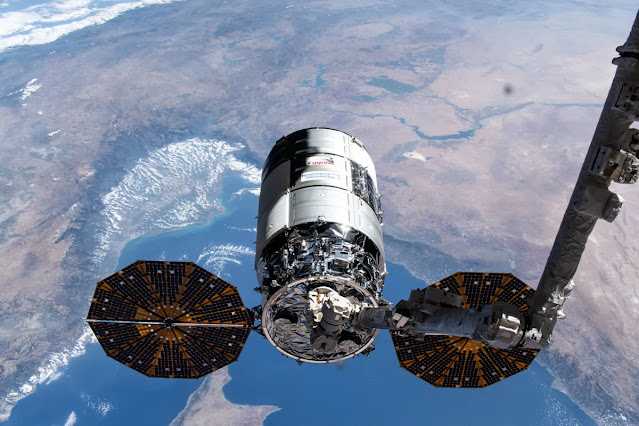NASA as extended the contracts of the three companies that fly the Commercial Resupply Service (CRS) cargo flights to the Space Station, through the expected rest of the life of the ISS.
In procurement filings Nov. 8, NASA stated it planned to extend the existing Commercial Resupply Services (CRS) 2 contracts with Northrop Grumman, Sierra Space and SpaceX that were set to expire at the end of 2026 through the end of 2030. NASA’s current plans call for retiring the ISS in 2030.
The three companies received CRS-2 contracts in 2016, and NASA announced in March 2023 its intent to extend the contracts. “There are no other CRS-2 certified visiting vehicles in the current marketplace for providing cargo resupply to the ISS,” NASA stated in a document justifying the extension of the three contracts. “Extension of the existing contracts is the most effective means of ensuring continued provision of these services for the extended duration of the ISS.”
The source article goes into more detail than it seems to deserve, but in March of '23 NASA specifically invited new companies to submit proposals to join the current three contractors. I say more detail than it seems to deserve because none of the three went any farther than that first submission.
One response came from Gravitics, a company developing modules for future commercial space stations, including one called StarMax. “The response does not provide a description of an end-to-end cargo service capable of reaching, attaching, and departing the ISS, but suggests a next generation launch vehicle could get it to low Earth orbit,”...
A second response came from The Exploration Company, a European startup developing cargo return spacecraft. NASA apparently dismissed them because they were to use only US-based companies.
Finally, a third response came from GEPA Logistics, which NASA described as a British company that handles land, sea and air cargo transportation but does not appear to have any experience in space transportation. It seems that not having any space launch capabilities would be an automatic disqualifier for a space launch job.
SpaceNews goes on to say that the CRS-2 contracts have a combined
not-to-exceed value of $14 billion - through the end of the program in
2030. According to SpaceNews NASA has obligated $2.7 billion to Northrop
Grumman, $1.4 billion to Sierra Space and $2.8 billion to SpaceX to date, for
a total of $6.9 billion. Doubling that gets the cost to $13.8 billion so it
doesn't seem to have much room to stay under $14 billion. Also,
there's no mention of the fact that while SpaceX has been obligated $2.8
billion to Northrop Grumman's $2.7, SpaceX has provided launch services for
their Cygnus cargo modules, since Northrop Grumman's launch vehicle went
non-procurable.
Northrop Grumman's Cygnus cargo ship arrives at the ISS and is guided to the docking port by the stations remote manipulator arm. This mission was in August 2024 and launched by SpaceX. Image Credit: NASA
Northrop Grumman has contracted with Firefly Aerospace to produce their new
Antares 330 launch vehicle for the Cygnus, and hope to have the first mission
"before the end of the year."

So... Sierra Space gets money even though they have yet to fly Dreamwhatever. Gee, has NASA learned absolutely nothing from the Crew Supply debacle?
ReplyDeleteAs to SpaceX, most likely they'll be flying Dreamwhatever unless operational tempo of Vulcan gets going much faster than 'maybe once a year, depending on BO's supply of engines.' SpaceX launches Cygnus, too, as the certification process for the Antares 330 is, I expect, going to be a long and troubling process.
Extension of CRS contracts right up to planned deorbit seems a budget building exercise.
ReplyDeleteThe three companies which submitted proposals though each failed to meet requirements seems about building brand recognition. The private space industry, while burgeoning, has yet to hit high gear. Getting your company out front, if even in name only, is a marketing strategy, to attract investors, and network with gov agencies. Probably.
Those three rejected companies knew they would not, indeed, could not, qualify, yet they submitted anyway.
Unclear is if GEPA could qualify as a U.S. provider at a future date.
I would hope NASA develops hard policy to require U.S. only.
Indeed, Rick - just imagine if Russia, China, or India submitted a bid that conformed to NASA's specs and was "cheaper"...
DeleteThis comment has been removed by a blog administrator.
ReplyDelete